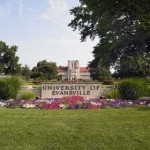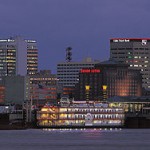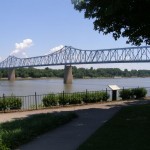My Musical Career|Part Nineteen
The Evansville Years – Part One
Late September and early October can be gloomy and rainy, and it certainly was the day I left Albany aboard that Greyhound bus bound for Evansville, Indiana. I had just closed out a most enjoyable three year period of my life, one in which I grew musically and personally, and was set to embark on a totally new phase of my life.. The cold front must have extended all the way from Albany to the Ohio River Valley, because it was
equally gloomy and rainy when I arrived in Evansville. I grabbed a cab and it took me and my luggage to the University’s guest quarters – which turned out to be in the President’s house. University President Dr. Wallace Graves was not present at the time, so the house was unoccupied. Once I put my stuff down and cleaned up, I hurried over to the Music Office in the Fine Arts Building. Mary Lee McManus was the lead secretary of the department at the time, ably assisted by Pat Yeager. These two ladies did all the administrative tasked of the department, and kept things rolling and on task.
The first order of business, after getting my paperwork sorted out was to get me settled in more permanent lodgings, as I could not stay in the President’s House indefinitely.
After a few phone calls, I managed to contact a Mrs. Ann Cassidy, who lived in an old ranch type house at 2165 Bellemeade Ave, a four block walk from the school. She was about seventy, but in full vim and vigor and had the energy and department of someone twenty years younger. She was willing to rent her basement apartment to college students, and I was fortunate in the fact that she hadn’t gotten any requests from students, so she had a vacancy. It turned out that it took up two thirds of the basement – one portion of it was furnished with two couches facing each other (one of these served nicely as a bed)– one on each side of the room – there were two end tables with lamps, several book shelves, and a large throw rug in the middle of the room. There was plenty of space to put my stero and speakers as well as records and books, and a dresser to put my clothing, as well as a pipe rack to hang my suits and coats. The other end of the room wasn’t totally finished, but there was a kitchen area with sink, cabinets, stove and oven as well as fridge, so eating in was no problem. I had bathroom privileges upstairs, and for 75 dollars month, this would work out just fine.
One I settled the business with Ann Cassidy, I moved my stuff into the basement apartment, and that became my base of operations for the better part of a year. I still did not drive, and while there was a bus system/public transportation in Evansville, it didn’t run as regularly as in Albany. I was lucky in that the University and the local food stores were all with walking distance, and laundry was not a problem as I had laundry privileges as well. So far so good. It was time to check out my environment.
Evansville and Owensboro
My Musical Career|Part Nineteen
Evansville was the county seat of Vanderburgh County and had a population of about 99,000 at the time. It is seated on a bend of the Ohio River separating Indiana from Kentucky. The main industries at the time were Whirlpool – which had a massive manufacturing plant on Route 41 north of the downtown area, and Mead-Johnson, which manufactured medicines and Infamil – this was closer to town. The University was located at 1800 Lincoln Avenue – about three miles from the downtown. It had a student population of 3,000 students when I taught there. It was a small, private, and well respected university, whose basketball teams were well-thought of in the NCAA. As a matter of fact, I joined the UE family just three years after one of its excellent basketball teams was killed in an plane crash while taking off from the local Dress Regional Airport. The memories still lingered, and a memorial to the students and staff who were killed had just been erected and dedicated.
Many of the university’s musical events were performed at the Wheeler Concert Hall in the Fine Arts Building, and there was a large and spacious rehearsal room across from Wheeler, which was also used for the Sunday rehearsals of the Evansville Philharmonic. On Fridays and Saturdays, the orchestra rehearsed downtown at the Civic Center, which is where the orchestra’s concerts were performed at the time.
Owensboro, Kentucky lays about forty miles east of Evansville, also on the Ohio River, although on the west bank. It had a population of about 50,000, and the Owensboro Symphony had its offices and rehearsal hall in a converted firehouse in the downtown area. Sunday rehearsals were held here, and Friday evening rehearsals , Saturday morning dress rehearsals and concerts were performed at the Daviess County High School. The orchestra put up those who traveled from Evansville and IU in Bloomington up at the Owensboro Days Inn for the Friday night/Saturday services. For the Sunday rehearsals, we of the Evansville contingent generally commuted. For the first year, I commuted with fellow principals from the EPO who were also principals with the OSO.
When I held the position of principal timpanist with both orchestras, each organization owned a set of Ludwig Dresden pedal timpani –sizes 23”,26”,29” and 32”. These were mid-seventies models, so they were relatively recent and had the suspended kettles, so their tone was good, and the kettles were much more in round than the old Ludwigs with which I had to put up with at the beginning of my Albany Symphony tenure.
I wish I could say as much for the pedal mechanism. I have always disliked that Ludwig Dresden pedal mechanism, as one could never get right on the pitch using the pedal, and the use of the master running handle was almost always required. If memory serves me correct, the Owensboro timpani were better, both in pitch and the mechanism was a little easier to operate than the Evansville drums, which had the new Remo heads – with the backbone line – and a stiffer pedal mechanism. That was the rub with the Ludwig Dresden mechanism. It was neither here nor there – instead, it was some sort of compromise and not a good one at that.
My Positions
Note that I head this section “My Positions”. The overall job title was “Consortium Position”, and there were three parts to it: Parts one and two were acting as principal timpanist of the Evansville Philharmonic and Owensboro Symphony orchestras. Part Three was acting as adjunct instructor of percussion at the University of Evansville. All of the other wind and brass principals of both the EPO and OSO were also on the faculty of the music department at the U of E. This was the first time that I would be in charge of a percussion program, and the responsibilities included teaching applied percussion (I had a studio of three students, a mix of freshman and sophomores), teach percussion methods; coach and conduct the percussion ensemble, and other duties as the department deemed appropriate, such as coaching the percussion students and the non –majors who took part in the band and orchestra.
The percussion studio was in the lower floor of the music building – most of the applied teacher’s studios were on the same floor and varied in size according to seniority. I was the low man on the totem pole – while my studio was not super small, it was not overly large. It was equipped with a desk and chair, file cabinets, a telephone, and a xylorimba – a good quality Deagan which was in excellent shape. I could switch it out and put four timpani in the room instead, but it would be a very close fit. There was a practice room next to mine which was used for timpani practice – there were a set of Rogers Acu-Sonic timpani (another one of the types of timpani that never fulfilled its promise and that were not fondly remembered by a generation of timpanists) in that room, and the student would practice on them.
The rest of the percussion instruments were stored in the rehearsal hall, which was shared by all of the ensembles. As it turned out, most of the equipment was of excellent quality – there were a good quality vibraphone, two good Musser marimbas in addition to the Deagan xylorimba, and the bells, snare drums, concert bass drum, etc. were in good repair. The only exception was the timpani. What they were using was a twenty-five year old set of Slingerland Rhapsody timpani that had seen quite a bit of use. The heads weren’t bad, but they had been on the drums for a time, and they were of the old-style “tight-fit” variety; in other words they were not extended collar. The sound was variable as the drums were in various conditions of roundness. There were four of these – the middle two were in the best of shape. These were used by all of the ensembles, plus by the EPO when that organization rehearsed at U of E on Sundays. This was less than an ideal situation and I had already determined to work out a situation where we could demote those old Slingerlands. Even the Rogers timpani held better pitch and this situation needed correcting.
There was a fourth part to the position – but one that was dependent on grant-writing, rather than a full part of the consortium. Officially, it was known as an Artist-In-Residence position, and it was designed to be centered in the Evansville-Vanderburgh School System. The grant was written by a group headed by a Mrs. Suzanne Beeson, approved by the Indiana Arts Council and it involved one semester’s work in a pre-selected school. I would introduce music into the everyday curriculum – science, math, etc. Plaza Park School was selected for the spring semester, and the stipend was $5000. A challenging season lay ahead, and one thing was certain – I was facing the biggest challenge and opportunity to date.




Recent Comments